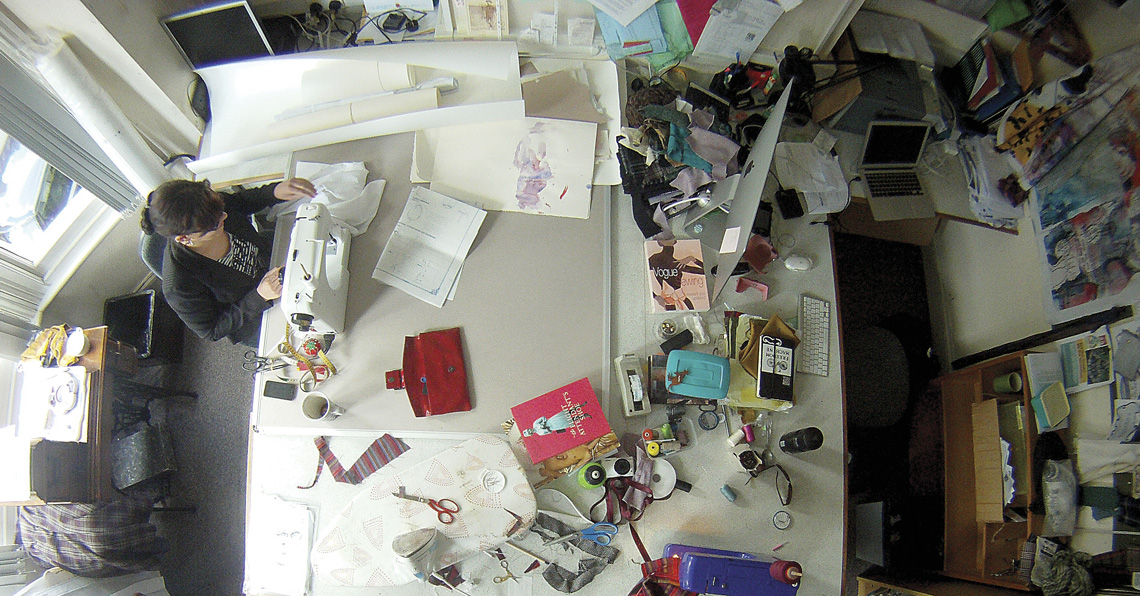Speculatively sewing historic clothing patents
Issue: XXVIII.4 July - August 2021Page: 15
Digital Citation
Authors:
Kat Jungnickel
For nearly a decade, I've been interested in historic clothing inventions and how "making things to make sense of things" [1] using visual and inventive methods might help me get closer (and in)to research in new ways. In my research and teaching at Goldsmiths I've explored ideas around gender, mobilities, and tech/maker cultures, especially in two projects: the ESRC-funded Bikes & Bloomers (B&B) [2] about early cycling cultures, where my research team and I reconstructed a collection of 1890s convertible cycling skirts; and the ERC-funded Politics of Patents (POP) [3], where we are speculatively sewing even more historic clothing inventions from 1820 to 2020. We ask: Can clothing inventions be read as acts of political resistance, contestation, or subversion and what kinds of citizens are made possible or reimagined across 200 years? I've also benefited from spending time with colleagues in the Transmissions project [4], where we experiment with less conventional ways of making and communicating research, such as sewing, poetry, performance, and sci-fi. This photo essay documents parts of these projects and some of the things we've learned along the way.
 |
I first became interested in patents when I stumbled across convertible cycling skirts invented by pioneering Victorian women committed to riding bicycles. I was fascinated with how they enabled wearers to secretly switch conventional middle- and upper-class women's streetwear into safe and comfortable cycle wear. This is an example of an 1896 patent for a cycling skirt that is also a cape. (Pat No. 13,832 Mary Elizabeth and Sara Anne Pease, Gentlewomen, Sunnyside, Grove Road, Harrogate, Yorkshire. 'Improves Skirt, available also as a Cape for Lady Cyclists,' April 11, 1895. Accessed at the EPO Espacenet: www.epo.org.) |
 |
The process of rendering patent data (back) into three dimensions is rarely straightforward. It involves trial and error—and mistakes and mess—and the making process is explored as an ethnographic enquiry. This photo captures a serendipitous moment of success with a tricky technique. Another challenge of speculative sewing lies in documenting practice when so much is happening. Here we stuck a camera on the studio ceiling to take photos every 10 seconds for a few weeks. Time-lapse videos can be found at http://katjungnickel.com/portfolio/time-lapse-videos/. |
 |
Interdisciplinary creative collaborations enrich practice research. This image shows artist Alice Angus [5] working with the B&B team to translate research stories into artworks. We digitally printed her paintings onto silk and sewed them into the linings of garments. They are revealed when the research is performed and the cycling skirts are converted. |
 |
Patterns inspired from patents helped us reconstruct the garments. We have since made them available as open-access PDF sewing pattern packs for others to interpret and share their results with us. So far they've been downloaded more than 18,500 times, all over the world. Access them at http://bikesandbloomers.com/patterns/. |
 |
The Transmissions project has also provided a platform to think strategically about the tactics of making and communicating research in less conventional forms, such as speculative sewing. It questions the usual research machines we employ, and suggests, "If you want different stories, try different machines." |
 |
Another key site for methodological experimentation is Methods Lab [6], a research collective in the sociology department that I co-direct with Rebecca Coleman. We are particularly interested in practice research, and run events such as annual lectures, workshops, and masterclasses to support and connect creative research in and outside academia. |
Politics of Patents (2019–2024) is funded by a European Research Council consolidator grant (#819458). Bikes & Bloomers and Transmissions were supported by an Economic and Social Research Council Knowledge Exchange grant and Intel Corporation (ES/K008048/1).
1. Jungnickel, K. Making things to make sense of things: DiY as research subject & practice. In The Routledge Companion to Media Studies and Digital Humanities. J. Sayers, ed. Routledge, London: New York, 2018, 492–502.
2. Bikes & Bloomers: http://bikesandbloomers.com
3. Politics of Patents: https://www.politicsofpatents.org/
4. Transmissions: http://trans-missions.katjungnickel.com/
5. Alice Angus: http://probos-cis.org.uk/about/people/alice-angus/
6. Methods Lab: http://www.methodslab.org
Kat Jungnickel is a senior lecturer in the Department of Sociology at Goldsmiths, University of London. She is co-director of the Methods Lab (www.MethodsLab.org) and PI on the European Research Council-funded project Politics of Patents (www.PoliticsofPatents.org). Recent books include Transmissions: Critical Tactics for Making and Communicating Research (2020), Creative Practice Ethnographies (coauthored with Larissa Hjorth, Anne M. Harris, and Gretchen Coombs, 2019), and Bikes and Bloomers: Victorian Women Inventors and Their Extraordinary Cycle Wear (2018). [email protected]
Copyright held by author
The Digital Library is published by the Association for Computing Machinery. Copyright © 2021 ACM, Inc.






